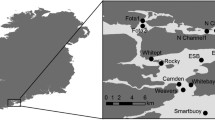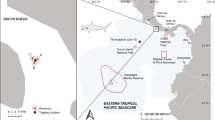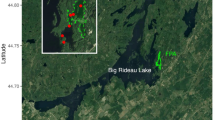Abstract
Permit (Trachinotus falcatus) occupy a variety of coastal marine habitats and support valuable recreational fisheries in their home region of the Caribbean Sea. As an aggregate spawning species, Permit require careful management in locations such as the Florida Keys where they experience substantial fishing pressure. We used acoustic telemetry to examine Permit residency patterns over 4 years amongst 12 high-residency sites that are likely important spawning (natural or artificial reefs) or foraging (seagrass flats) habitats. Residency was highest in artificial reefs, supporting previous research that suggests Permit have high fidelity to these habitats compared to seagrass flats and natural reefs on the Florida Reef Tract, which are highly connected. Residency peaked in the spring and summer months in most sites, with a marked decline in the late fall, suggesting potential undetected movement outside the region during that period. Permit exhibited high residency at an important spawning site in March, indicating that this spawning aggregation is vulnerable to fishing pressure with current regulations, which protect Permit from April through July. Seagrass flats in close proximity (<10 km) to spawning locations are likely of high importance to Permit as a food source during the extensive spawning season. Permit residency was generally consistent amongst water temperatures, although residency patterns varied with temperature amongst sites. Residency at natural reef spawning sites increased leading up to the full moon, which is a potential spawning cue for this species. These findings build on a body of recent research on Florida Keys Permit, providing residency information over space and time that may help to further guide the development of marine protected areas and fisheries regulations.






Similar content being viewed by others
Data availability
Data associated with this work will be made available upon reasonable request. Because these data describe the space use of an exploited species, it is prudent to restrict access to raw data.
All procedures were conducted in accordance with the Carleton University Animal Care Committee (application 11473), as well as the American Association for Laboratory Animal Science (IACUC protocol 2013-0031, University of Massachusetts Amherst). The authors declare no conflicts of interest. Aaron Adams, Andy Danylchuk, and Steve Cooke are Guest Editors of this special issue, but they were not involved in the peer review of this article and had no access to information regarding its peer review.
References
Adams AJ, Cooke SJ (2015) Advancing the science and management of flats fisheries for bonefish, tarpon, and permit. Environ Biol Fish 98:2123–2131. https://doi.org/10.1007/s10641-015-0446-9
Boucek RE, Leone E, Bickford J et al (2017) More than just a spawning location: examining fine scale space use of two estuarine fish species at a spawning aggregation site. Front Mar Sci 4:355. https://doi.org/10.3389/FMARS.2017.00355/BIBTEX
Boucek RE, Lewis JP, Stewart BD et al (2019) Measuring site fidelity and homesite-to-pre-spawning site connectivity of bonefish (Albula vulpes): using mark-recapture to inform habitat conservation. Environ Biol Fish 102:185–195. https://doi.org/10.1007/S10641-018-0827-Y/FIGURES/5
Breiman L (2001) Random forests. Mach Learn 45:5–32. https://doi.org/10.1023/A:1010933404324
Breiman L, Friedman J, Olshen R, Stone C (1984) Classification and regression trees. Routledge, New York
Brownscombe JW, Adams AJ, Young N et al (2019) Bridging the knowledge-action gap: a case of research rapidly impacting recreational fisheries policy. Mar Policy 104:210–215. https://doi.org/10.1016/j.marpol.2019.02.021
Brownscombe JW, Griffin LP, Morley D et al (2020a) Seasonal occupancy and connectivity amongst nearshore flats and reef habitats by permit Trachinotus falcatus: considerations for fisheries management. J Fish Biol 96:469–479. https://doi.org/10.1111/jfb.14227
Brownscombe JW, Griffin LP, Morley D et al (2020b) Application of machine learning algorithms to identify cryptic reproductive habitats using diverse information sources. Oecologia 194:283–298. https://doi.org/10.1007/s00442-020-04753-2
Brownscombe JW, Midwood JD, Cooke SJ (2021) Modeling fish habitat – model tuning, fit metrics, and applications. Aquat Sci 83:1–14
Brownscombe J, Shipley O, Griffin L et al (2022) Application of telemetry and stable isotope analyses to inform the resource ecology and management of a marine fish. J Appl Ecol 59:1110–1121
Cohen J (1988) Statistical power analysis for the behavioral sciences. Routledge, New York
Crabtree RE, Hood PB, Snodgrass D (2002) Age, growth, and reproduction of permit (Trachinotus falcatus) in Florida waters. Fish Bull 100:26–34
Danylchuk AJ, Cooke SJ, Goldberg TL et al (2011) Aggregations and offshore movements as indicators of spawning activity of bonefish (Albula vulpes) in The Bahamas. Mar Biol 158:1981–1999. https://doi.org/10.1007/s00227-011-1707-6
De Mitcheson YS, Colin PL (2012) Reef fish spawning aggregations: biology, research and management. Springer, New York
De’Ath G, Fabricius KE (2000) Classification and regression trees: a powerful yet simple technique for ecological data analysis. Ecology 81:3178–3192
Erisman BE, Allen LG, Claisse JT et al (2011) The illusion of plenty: hyperstability masks collapses in two recreational fisheries that target fish spawning aggregations. Can J Fish Aquat Sci 68:1705–1716. https://doi.org/10.1139/f2011-090
Erisman B, Heyman W, Kobara S et al (2017) Fish spawning aggregations: where well-placed management actions can yield big benefits for fisheries and conservation. Fish Fish 18:128–144. https://doi.org/10.1111/faf.12132
Garcia-Cagide A, Claro R, Koshelev BV (2001) Reproductive patterns of fishes of the Cuban shelf. In: Claro R, Lindeman KC, Parenti LR (eds) Ecology of the marine fishes of Cuba. Lindeman & Smithsonian Institution Press, Washington, DC
Graham RT, Castellanos DW (2005) Courtship and spawning behaviors of carangid species in Belize. Fish Bull 103:426–432
Greenwell BM (2017) pdp: an R package for constructing partial dependence plots. R J. https://doi.org/10.32614/rj-2017-016
Holder PE, Griffin LP, Adams AJ et al (2020) Stress, predators, and survival: exploring permit (Trachinotus falcatus) catch-and-release fishing mortality in the Florida Keys. J Exp Mar Bio Ecol 524:151289
Kahle D, Wickham H (2013) ggmap: spatial visualization with ggplot2. R J 5:144–161
Kuhn M, Wing J, Weston S et al (2019) caret: classification and regression training. Astrophys Source Code Libr ascl-1505. R package version 6.0-84. https://cran.r-project.org/package=caret
Liaw A, Wiener M (2002) Classification and regression by randomForest. R News 2:18–22. https://doi.org/10.1177/154405910408300516
Molnar C (2019) Interpretable machine learning. A guide for making black box models explainable. Lean Publishing
Mourier J, Maynard J, Parravicini V et al (2016) Extreme inverted trophic pyramid of reef sharks supported by spawning groupers. Curr Biol 26:2011–2016. https://doi.org/10.1016/j.cub.2016.05.058
R Core Team (2019) R: a language and environment for statistical computing. R Foundation for Statistical Computing. Vienna, Austria. https://www.r-project.org/
Rassweiler A, Costello C, Siegel DA (2012) Marine protected areas and the value of spatially optimized fishery management. Proc Natl Acad Sci U S A 109:11884–11889. https://doi.org/10.1073/pnas.1116193109
RStudio Team (2016) RStudio: integrated development for R. RStudio, Inc. Boston, MA, USA. http://www.rstudio.com/
Rudolfsen TA, Watkinson DA, Charles C et al (2021) Develo** habitat associations for fishes in Lake Winnipeg by linking large scale bathymetric and substrate data with fish telemetry detections. J Great Lakes Res 47:635–647. https://doi.org/10.1016/j.jglr.2021.02.002
Waterhouse L, Heppell SA, Pattengill-Semmens CV et al (2020) Recovery of critically endangered Nassau grouper (Epinephelus striatus) in the Cayman Islands following targeted conservation actions. Proc Natl Acad Sci USA 117:1587–1595. https://doi.org/10.1073/pnas.1917132117
Wickham H (2016) ggplot2: elegant graphics for data analysis. http://ggplot2.org. Accessed 8 Nov 2021
Wickham H, François R, Henry L, Müller K (2021) dplyr: a grammar of data manipulation. R package version 1.0.9. https://CRAN.R-project.org/package=dplyr
Zuur A, Ieno E, Saveliev A (2017) Spatial, temporal and spatial-temporal ecology data analysis with R-INLA. Highland Statistics Ltd., Newburgh, United Kingdom
Funding
This project was funded by Bonefish & Tarpon Trust with support from Costa Del Mar, The March Merkin Fishing Tournament, Hell’s Bay Boatworks, and private donations. Additional support was provided by a NASEM Gulf Research Program through a hurricane recovery grant, and the acoustic receiver array was partially supported by a loan from the Ocean Tracking Network. We thank the fishing guides and anglers who assisted with the telemetry array design and Permit tagging for this project including Captains Travis and Bear Holeman, Will Benson, Rob Kramarz, Zack Stells, Brandon and Jared Cyr, Chris Trosset, Nathaniel Linville, Ian Slater, Augustine Moss, Sandy Horn, Ted Margo, Richard Berlin, and Jeff Rella. We also thank the researchers who shared permit acoustic telemetry detection data with us through integrated Tracking of Animals in the Gulf (iTAG) and Florida Acoustic Telemetry Network (FACT), in particular Harold “Wes” Pratt of Mote Marine Laboratory, funded by The Shark Foundation/Hai Stiftung, and Mike McAllister. Thank you to Dr. Susan Lowerre-Barbieri from the Florida Fish and Wildlife Conservation Commission for providing acoustic receiver coverage. Brownscombe is supported by a Banting Postdoctoral Fellowship, Dalhousie University, Carleton University, and Bonefish & Tarpon Trust. This research was conducted with permission of the Florida Keys National Marine Sanctuary under permit # FKNMS-2013-040-A2 and the Florida Fish and Wildlife Conservation Commission under permit # SAL-16-1205.
Author information
Authors and Affiliations
Corresponding author
Additional information
Publisher's note
Springer Nature remains neutral with regard to jurisdictional claims in published maps and institutional affiliations.
Supplementary Information
Below is the link to the electronic supplementary material.
Rights and permissions
Springer Nature or its licensor holds exclusive rights to this article under a publishing agreement with the author(s) or other rightsholder(s); author self-archiving of the accepted manuscript version of this article is solely governed by the terms of such publishing agreement and applicable law.
About this article
Cite this article
Brownscombe, J.W., Griffin, L.P., Morley, D. et al. Spatial-temporal patterns of Permit (Trachinotus falcatus) habitat residency in the Florida Keys, USA. Environ Biol Fish 106, 419–431 (2023). https://doi.org/10.1007/s10641-022-01332-7
Received:
Accepted:
Published:
Issue Date:
DOI: https://doi.org/10.1007/s10641-022-01332-7




